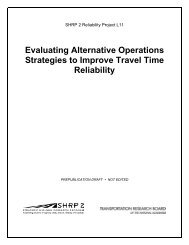Contemporary Approaches to Parking Pricing: - FHWA Operations
Contemporary Approaches to Parking Pricing: - FHWA Operations
Contemporary Approaches to Parking Pricing: - FHWA Operations
Create successful ePaper yourself
Turn your PDF publications into a flip-book with our unique Google optimized e-Paper software.
San Francisco encourages unbundled parking through low parking maximums. In down<strong>to</strong>wn San Francisco developers<br />
can build only 0.75 parking spaces per housing unit and that number drops as low as 0.5 in some neighborhoods.<br />
Preventing developers from constructing at least one parking space per housing unit can be a big inducement <strong>to</strong> unbundle<br />
parking at residential units. In such cases, developers failing <strong>to</strong> unbundle parking would be left with the unappealing<br />
prospect of having <strong>to</strong> sell or lease units that are guaranteed <strong>to</strong> lack access <strong>to</strong> off-street parking.<br />
The mechanism through which parking taxes and fees can be implemented will vary by state and local government.<br />
The process should be well known <strong>to</strong> government officials, but careful consideration is recommended. The Ontario<br />
provincial government unsuccessfully attempted <strong>to</strong> implement a commercial concentration tax, similar <strong>to</strong> a property<br />
tax, that affected large-scale, paid-parking facilities. The tax had the adverse effect of causing those controlling suburban<br />
parking facilities that had charged low fees <strong>to</strong> discontinue those fees <strong>to</strong> avoid the tax. In most cases the tax exceeded<br />
the earned parking revenue, which made it cheaper for parking facilities <strong>to</strong> s<strong>to</strong>p charging for parking than <strong>to</strong><br />
pay the tax. This resulted in the majority of the tax’s revenue being generated in the Toron<strong>to</strong> CBD where the tax represented<br />
a small cost in proportion <strong>to</strong> <strong>to</strong>tal parking revenue. While tax funds were coming primarily from the CBD<br />
they were being spent outside of Toron<strong>to</strong>, causing significant discontent. These negative impacts were not anticipated<br />
and the law was quickly repealed (IBI Group, et al. 2000).<br />
When implementing commuter parking pricing strategies, government agencies need <strong>to</strong> consider a number of items<br />
that are described below.<br />
• Any new policies should be developed in coordination with developers and employers.<br />
• Many communities have regional or local commute options agencies that can assist with strategy development and<br />
program implementation.<br />
• Developers should not be forced <strong>to</strong> construct and maintain more parking than there is demand for. The policies that<br />
fail <strong>to</strong> assure this will force developers <strong>to</strong> work <strong>to</strong> simultaneously reduce parking demand while financing and maintaining<br />
unused parking spaces. As is the case in California, developers should be allowed <strong>to</strong> decrease the number of<br />
available parking spaces if demand decreases.<br />
• <strong>Parking</strong> cash-out policies are likely <strong>to</strong> create spill-over effects if nearby parking is not restricted or priced. Some sites<br />
have documented that occasionally employees who accept a parking cash out continue <strong>to</strong> drive but park in a nearby<br />
neighborhood where parking is free. Employers can help address this externality by developing policies that prohibit<br />
cash-out recipients from parking in residential neighborhoods and revoking program eligibility for employees who fail<br />
<strong>to</strong> comply. Government agencies can help address this issue by following the model of California’s cash-out law, which<br />
explicitly allows employers the ability <strong>to</strong> revoke eligibility when employees fail <strong>to</strong> comply with company established<br />
cash-out guidelines. Charging or requiring permits for parking in affected residential neighborhoods, as discussed in<br />
the Residential <strong>Parking</strong> Permit section of this primer, can also address the issue.<br />
• Programs must recognize that most employees will occasionally need their vehicle for errands before work, at mid-day,<br />
or after work and should provide parking options for these individuals. This can generally be done by providing commuters<br />
with a limited number of free parking days or allowing them <strong>to</strong> purchase parking on a daily basis.<br />
• All programs should include measureable performance goals that are tracked after program implementation.<br />
An effectively implemented commuter parking pricing strategy can reduce vehicle trips. The strategies discussed assign a<br />
value <strong>to</strong> parking that would otherwise be free or offered at an artificially low rate <strong>to</strong> the user. Overall, commuter parking<br />
pricing strategies offer some solutions <strong>to</strong> address the market dis<strong>to</strong>rtions created by the supply of free commuter parking.<br />
C o n t e m p o r a r y A p p r o a c h e s t o P a r k i n g P r i c i n g | 21















